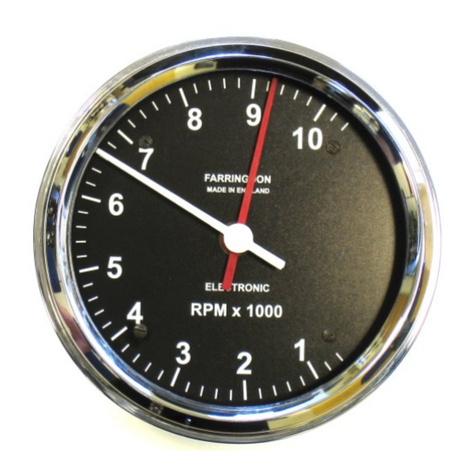
3. Setting Up Your Tachometer
There are five settings that must be adjusted before you can use the tacho. These are
1. The number of cylinders or pulses form the engine for every two turns of the engine
2. The mode of operation. This is mainly the tell-tale reset mode
3. The trigger pulse filter. This allows you to use a wide range of pulse widths for the trigger
input.
4. The rpm at which shift light 1 comes on and the rpm at which shift light 2 comes on and
both lights flash.
To revert to factory setup, enter setup mode by turning on the tacho with the button pressed,
release the button and then press it again for 20 seconds.
3.1 Using the push button
Having the tell-tale hand makes setting up very easy as the red tell-tale hand shows what you are
setting up and the white main hand shows the value of the setting. The button is used to
increase the value of the setting, with a quick push, to decrease the value with a push of about 2
seconds and to go on to the next setting with a push of 5 seconds. You will find this easier than
it sounds!
In the following paragraphs, numbers refer to the first digit on the tacho scale; e.g. when setting
the cylinders to 4, the white hand has to be set to 4000 rpm however this is marked, maybe 4 or
40.
To enter set up mode, hold the push button down and then apply the power. The tell-tale needle
will move to 1 (the first set up item) and the main hand will show the currently set no of cylinders.
When the needles have stopped moving, release the button.
3.2 Number of Cylinders (tell-tale at 1)
In order to allow for uneven firing engines, Farringdon uses thenumber of trigger pulsesin two full
turns of the engine to calculate the rpm. Unless you have a special sensor, this is likely to be the
number of cylinders connected to the coil you are using.
Use the push button to increase or decrease the number shown by the main hand until it is
correct. Then hold the push button pressed for 5 seconds to move on to the next set up item.
Note. If the red hand indicated 1500 rpm, this shows that the number of cylinders has been set to
the max and has wrapped over. E.g If the red hand is on 1500 rpm and the white on 4000 rpm,
then the tacho has been set to 8+4 (for a 0 to 8000 tacho) cylinders. Press the button for 20
seconds to start again from the factory setting.




























